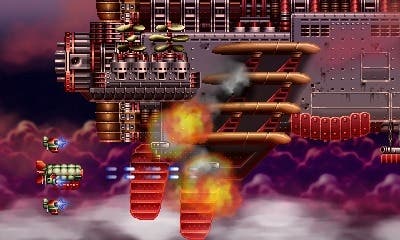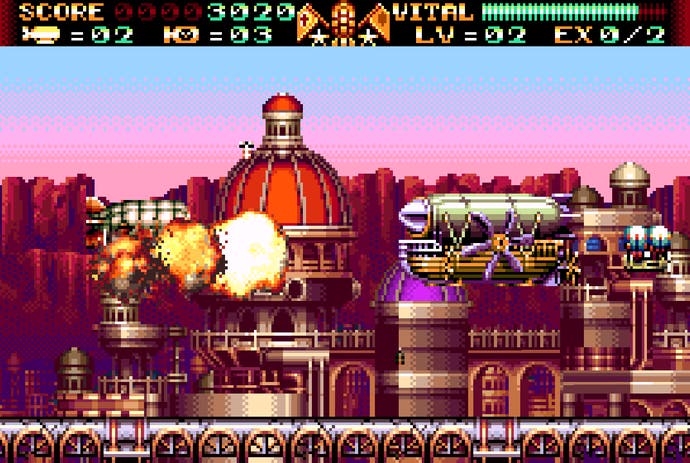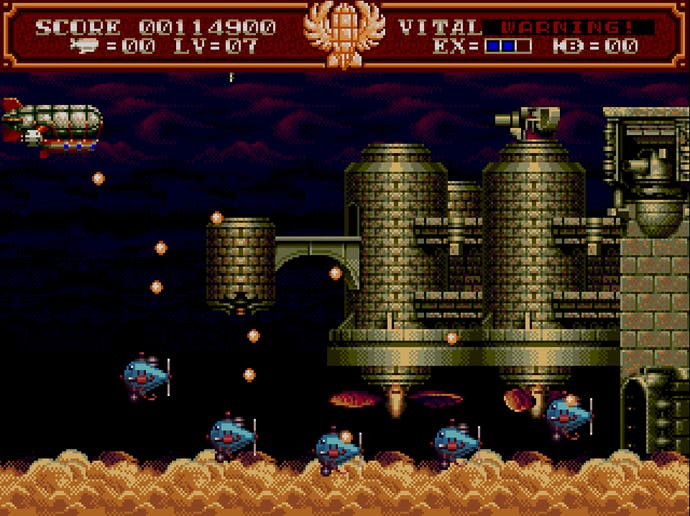Steel Empire retrospective
Steam powered.
Hayao Miyazaki sure has a lot to answer for. One of the leading lights of Japanese animation for the past six decades, Miyazaki's body of work has entertained and influenced countless millions - Steven Spielberg and John Lasseter are both vocal fans - and the many unique worlds he has created have spawned countless tributes and imitations. 1986's Laputa: Castle in the Sky is one of the most significant Miyazaki productions, building on the theme of gigantic aerial battleships that he would tentatively explore in the 1970s anime series Future Boy Conan.
Laputa's plot wasn't solely concerned with these airborne behemoths, finding time for plenty of magic, robot guardians and one of the most exciting railway chases in the history of cinema, but they would provide ample inspiration for the likes of Final Fantasy creator Hironobu Sakaguchi - who has stated that the airships in the series were influenced by Miyazaki - and fellow Japanese developer Yoshinori Satake, who, during his tenure at Tokyo-based studio Hot・B created what is possibly the most perfect unofficial homage to Laputa in the form of Koutetsu Teikoku - better known in the west as Steel Empire.

Released on the Sega Mega Drive at a time when scrolling shooters were available in abundance, Steel Empire's steampunk aesthetic allowed it to stand out from the crowd. Instead of piloting a traditionally sleek and futuristic fighter craft like R-Type's R-9a Arrowhead or Gradius' Vic Viper, players were offered the choice of a flimsy, canvas-winged plane or a plump, almost comical-looking zeppelin - the only combat craft available to the plucky but technologically savvy Republic of Silverhead. Rather than rallying against a sinister alien menace from beyond the stars, your enemy was the malevolent Motorhead Empire (the regions in the game were named after rock bands, in case it wasn't obvious) and its immense fleet of propeller-driven airships, armoured trains and other "alternative future" tech.
To say Steel Empire was a refreshing change would be a massive understatement; if Jules Verne had somehow been transported from the 1800s and given the opportunity to try his hand at creating a horizontally-scrolling blaster, this surely wouldn't have been a million miles from what he would have concocted. The fanciful final level opens with your ship being fired into space by a giant cannon before moving onto the moon, imitating the naive science fiction theory of the Victorian era; people blindly assumed that there was atmosphere in space, so the propellor-driven craft in Steel Empire are just as comfortable cutting through the inky black void as they are dashing around the cloud-packed skies of planet Earth.
Satake's desire to create an authentic vision of a steampunk future extended to other aspects of Steel Empire's presentation. Cutscenes look like they're being viewed through an old-fashioned projector and the end credits run in the same manner you would expect to see on a Hollywood movie. 16:9 widescreen framing is also employed at certain points to reinforce the cinematic connection. The title screen has the musical notation of the theme tune scrolling along the bottom - another very deliberate nod to the past, when silent movies would be accompanied by a live orchestra, which would play out of sight behind the audience.

While Satake was content to immerse the game in the past, Steel Empire was surprisingly innovative in its own fashion. Players are able to fire both left and right using different buttons, allowing you to tackle enemies swarming in from both sides. The underground mine in level two begins as a standard left-to-right scrolling section, but upon defeating the boss, your craft performs a frantic 180-degree turn and must dash in the opposite direction to escape the collapsing network of subterranean caves.
Level three's massive, multi-screen flying fortress may borrow heavily from a similar stage in Irem's R-Type, but it delivers on a much grander scale; the monstrous Motorhead battleship only succumbs when the player successfully blows open its metal belly to expose its weak spot. Then there's the aforementioned flight into the cold vacuum of space in pursuit of Motorhead's maniacal leader, Sauron (or Styron, if you're playing the western version - presumably Acclaim, who localised the game, was fearful of legal action from the estate of J.R.R. Tolkien). Each level is inventive and packed with fresh ideas, and back in 1992 this provided the perfect tonic to the hordes of 'me too' blasters which flooded the Mega Drive's already shooter-rich library.
Perhaps the most unique element of Steel Empire is its levelling system, which Satake admits borrows heavily from classic JRPGs such as Enix's seminal Dragon Quest. Collecting three power-up icons increases your craft's level and enhances its firepower, and because progress is retained even when you lose all of your lives and continue, beginners have a shot at seeing the latter portion of the game. Even the game's scoring system is geared towards novice players; additional points are awarded for stockpiling bombs and avoiding a single hit throughout an entire stage, but little focus is given to racking up an impressive total - Satake states that he wanted the game to feel inclusive rather than exclusive, and feared that newcomers might be disheartened by their poor scoring performance when compared to seasoned shooter experts.

The small amount of text meant that bringing the game to the west was a reasonably straightforward affair, and Steel Empire would hit North America and Europe in 1992 - the ideal time to capitalize on the commercial success of Sega's 16-bit system in those regions. Sadly, Hot・B went bankrupt in 1993 but its assets and IP were acquired by Starfish, a company formed by former Hot・B staff. Since then, the game's appeal has endured; while the North American and PAL versions are common on the second-hand market, the Japanese version - complete with gorgeous Miyazaki-inspired cover artwork - is highly sought after.
Steel Empire's passionate following in Japan was sufficient enough to bring about the development of a Game Boy Advance version in 2004; compiled from a ROM image as the original source code for the Mega Drive version has sadly been lost, it remains a reasonably faithful replication, although the smaller screen necessitated changes to both the level and enemy design. A European release followed in 2005 thanks to now-departed UK firm Zoo Digital Publishing, but it wasn't picked up for North America. More recently, Steel Empire has resurrected in its native Japan as a 3DS eShop download. Spruced up with new graphical effects and enhanced music - as well as superb support for the console's auto-stereoscopic display - the game has already been confirmed for North American release this summer by publisher Starfish. Fingers are firmly crossed that a European launch follows shortly afterwards.
Satake is well aware of the level of veneration which exists for his most famous video game creation, and has spoken of his desire to develop a sequel - provisionally titled "Burning Steel" - in the past. He says he wants to make the shooter accessible again, just as he and his team at Hot・B tried to do with Steel Empire. According to the veteran developer, plans have been submitted to Starfish, the approval of which will presumably be subject to the commercial success of the 3DS version of Steel Empire. In this era of crowdfunding and independent publishing the chances of such a sequel appearing have arguably never been better, but even if Satake is unsuccessful in making his pitch a reality, he will hopefully find contentment in the fact that over two decades ago he crafted one of the most original and enduring shooters of the 16-bit era; a game which continues to enthral existing fans and - thanks to the 3DS version - is set to enrapture an entirely fresh generation of players.









